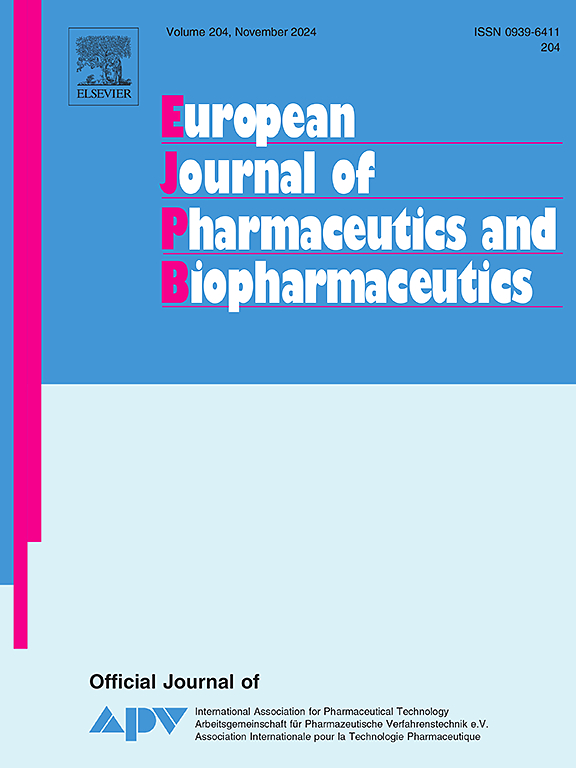人工肠道模拟器。预测弱碱性BCS-II药物双嘧达莫肠道和血浆浓度-时间分布的方案。
IF 4.4
2区 医学
Q1 PHARMACOLOGY & PHARMACY
European Journal of Pharmaceutics and Biopharmaceutics
Pub Date : 2025-03-13
DOI:10.1016/j.ejpb.2025.114688
引用次数: 0
摘要
本研究的目的是建立一种方案来预测弱碱性BCS-II药物双嘧达莫(DPD)的肠道和血浆浓度-时间分布,使用人工肠道模拟器(AGS)与基于室的处置模型相结合。该研究的体内数据来自先前发表的文献。利用静脉给药后DPD的血浆浓度-时间谱建立了3室处置模型。AGS由供体细胞和中空纤维基吸收模块组成,根据测量的Caco-2细胞单层渗透系数,调整为以生理速率常数0.0402 min-1吸收DPD饱和溶液。溶出试验中常用的剂量倾倒技术会产生过高的初始过饱和和沉淀,这与生理无关。在本研究中,每15 min向AGS供体逐渐添加部分DPD剂量,以模拟整体一级胃排空过程。由中空纤维接收介质吸收的浓度输入到配置模型的中央室。预测的血浆浓度-时间分布与口服50 mg剂量后获得的人体内DPD分布相匹配。口服剂量为30和90 mg时,AGS供体中沉淀的浓度和分数的时间分布与人十二指肠测量结果吻合良好。本研究证明体外模拟生理吸收速率对准确预测BCS-II类化合物的生物利用度具有重要意义。本文章由计算机程序翻译,如有差异,请以英文原文为准。

Artificial gut Simulator. A scheme to predict intestinal and plasma concentration–time profiles of a weakly basic BCS-II drug, dipyridamole
The objective of this study was to develop a scheme to predict intestinal and plasma concentration–time profiles of the weakly basic BCS-II drug, dipyridamole (DPD), using an Artificial Gut Simulator (AGS) integrated with a compartment-based disposition model. In vivo data for this study was obtained from previously published literature. A 3-compartment disposition model was developed using the plasma concentration–time profile of DPD following an intravenous bolus dose. The AGS, consisting of a donor cell and a hollow fiber-based absorption module, was tuned to absorb DPD saturated solution at a physiological rate constant, 0.0402 min−1, based on the measured Caco-2 cell monolayer permeability coefficient. The dose dumping technique commonly used during dissolution testing can generate excessively high initial supersaturation and precipitation which is not physiologically relevant. In this study, fractions of DPD dose were added incrementally every 15 min to the AGS donor to simulate an overall first-order gastric emptying process. The concentration absorbed by the hollow fiber receiver media was input into the central compartment of the disposition model. The predicted plasma concentration–time profile matched the human in vivo profile of DPD obtained after oral administration of a 50 mg dose. For 30 and 90 mg oral doses, time profiles of concentration and fraction precipitated in the AGS donor agreed well with human duodenal measurements. This study demonstrates the significance of simulating physiological rate of absorption in vitro to accurately predict the bioavailability of a BCS-II compound.
求助全文
通过发布文献求助,成功后即可免费获取论文全文。
去求助
来源期刊
CiteScore
8.80
自引率
4.10%
发文量
211
审稿时长
36 days
期刊介绍:
The European Journal of Pharmaceutics and Biopharmaceutics provides a medium for the publication of novel, innovative and hypothesis-driven research from the areas of Pharmaceutics and Biopharmaceutics.
Topics covered include for example:
Design and development of drug delivery systems for pharmaceuticals and biopharmaceuticals (small molecules, proteins, nucleic acids)
Aspects of manufacturing process design
Biomedical aspects of drug product design
Strategies and formulations for controlled drug transport across biological barriers
Physicochemical aspects of drug product development
Novel excipients for drug product design
Drug delivery and controlled release systems for systemic and local applications
Nanomaterials for therapeutic and diagnostic purposes
Advanced therapy medicinal products
Medical devices supporting a distinct pharmacological effect.

 求助内容:
求助内容: 应助结果提醒方式:
应助结果提醒方式:


